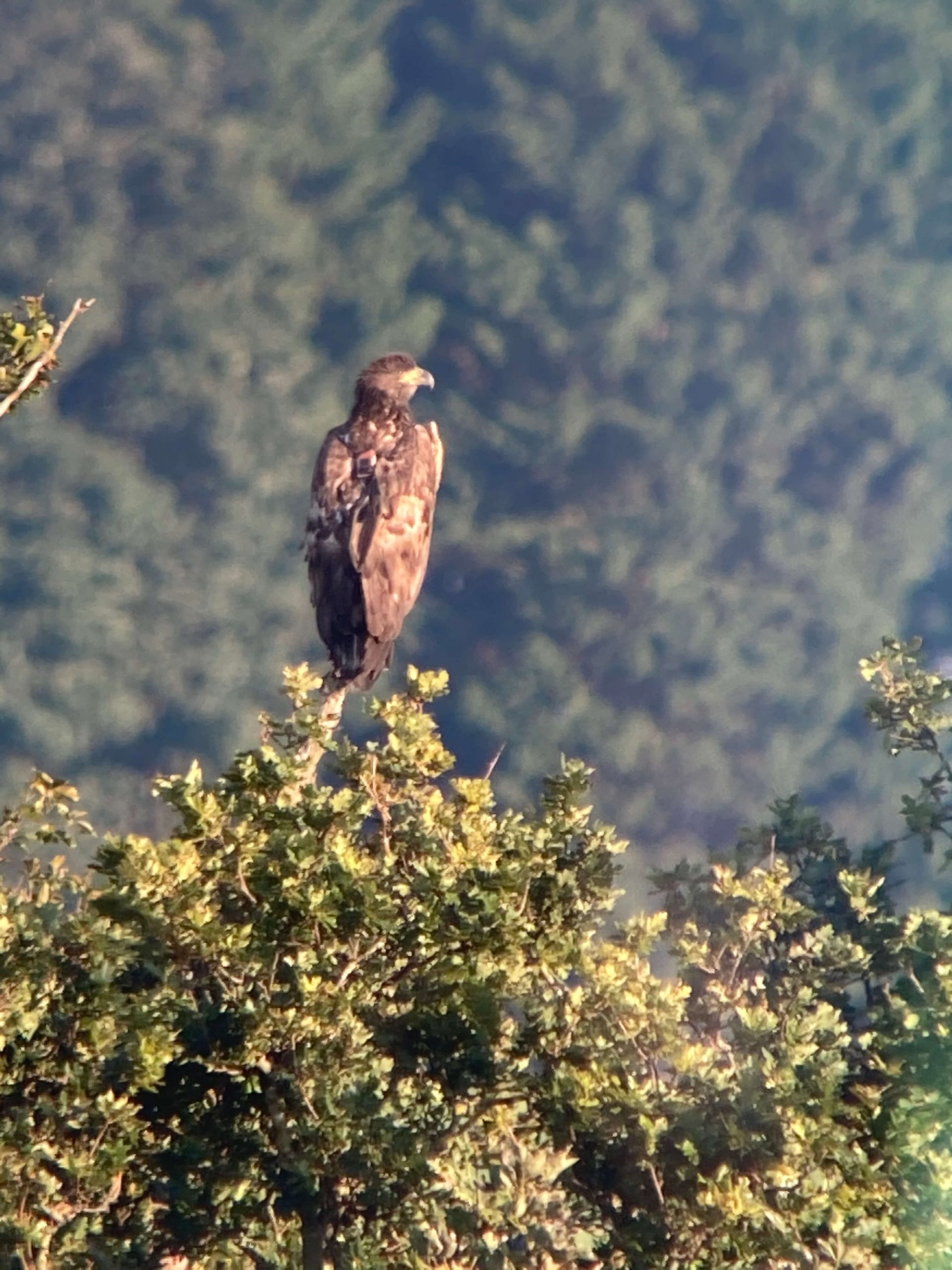


Headline photo: a White-tailed Eagle from the Isle of Wight (G393) at Wild Ken Hill in September 2020. Several members of the Wild Ken Hill team were lucky enough to glimpse the bird.
Below our Project Manager Dom explains why these proposals are being brought forward, and what benefits he expects the project to bring should it go ahead.
Several members of the Wild Ken Hill team were fortunate enough to see a White-tailed Eagle at Wild Ken Hill in September 2020. The bird had been reintroduced to the Isle of Wight (labelled G393) in 2019, and it arrived in Norfolk having spent time in the North Yorkshire moors.
It was a magnificent site to watch the juvenile eagle flap its large, rectangular wings with finger-like tips before perching in a series of trees as pictured above. We watched the bird for two hours, not quite able to pull ourselves away.
Should these proposals go ahead, as residents of West Norfolk and the surrounding area, we would have the wonderful opportunity to live alongside this magnificent native bird, and to take pleasure from watching it soar across our skies. This can only be a good thing for nature conservation and our relationship with the natural environment, and we hope local people can get behind these proposals by taking the online survey.
These proposals also represent a wonderful opportunity for farmers and other landmanagers to showcase the excellent work they do as stewards of our countryside. The White-tailed Eagle is the UK’s largest native bird of prey, sadly persecuted to extinction by humans around 100 years ago. If we are to be true environmental stewards, then surely we have a moral obligation to restore such species where it is feasible.
Of course, the feasibility of such proposals can only be determined with a comprehensive assessment of the potential benefits, costs, opportunities and risks associated with a reintroduction. In this instance, we are in a great position to understand these because of the very encouraging initial results from the south of England reintroduction, which is centred around the Isle of Wight and began in 2019.
The Isle of Wight project, perhaps along with the Netherlands, are the best case studies for the Norfolk proposals given similarities in the coastal, lowland habitats and excellent availability of natural prey.
To date, 13 birds have been released on the Isle of Wight, and a variety of concerns aired at the time of those proposals around farming and disturbance to existing wildlife have not been realised. Rather, a broad church of people from the countryside have instead had the wonderful opportunity to see these birds first hand.
The birds’ diet has mostly consisted of wild fish, carrion, rabbits, and gulls, which the project team are able to verify by satellite-tracking the birds and visiting sites where they frequently roost to inspect the remains of any prey.
Indeed, we were keenly following the behaviour of G393 as it moved through the Norfolk landscape in 2020, including spending a significant time at West Acre to the south-east of Wild Ken Hill.
It was extremely encouraging to hear from our friends over there that although the bird had spent plenty of time around outdoor pig units, that there had been no trouble at all. In fact, G393 had been feeding on gulls sitting on an inland reservoir.
Evidence from the Isle of Wight project, as well as the large body of research from Europe where there are thousands of White-tailed Eagles, often living alonside people, has given us the confidence we need to bring these proposals forward for West Norfolk and the surrounding region.
A viable breeding population in West Norfolk would complement extremely well the efforts to restore this bird in Scotland, Ireland and now the Isle of Wight, as well as the pan-European efforts to bring back the bird; connecting up these meta populations is expected to benefit the long-term conservation status of the species.
Moreover, restoring a flagship species to coastal and wetland ecosystems in Norfolk could have a number of direct and indirect environmental benefits. As an apex predator, the role that the White-tailed Eagle plays in controlling meso-predators such as Buzzards, as well as Cormorants and feral geese could well have knock-on benefits in the ecosystem.
With a flagship species like the White-tailed Eagle in place, we would also expect there to be a growth in accompanying habitat creation and enhancement in the area, such as the work already underway at Wild Ken Hill itself to improve freshwater marshes, create a new rewilding zone, and improve farmland biodiversity with regenerative farming techniques. There could also be an increase in environmental protections that improve the long-term integrity of ecosystems in the area.
But perhaps most importantly, as residents of this beautiful part of the country, we would have the wonderful opportunity to connect with nature, to live alongside this magnificent native bird, and to take pleasure from watching it soar across our big Norfolk skies. This can only be a good thing for nature conservation and our relationship with the natural environment. In sum, we think these proposals could bring forward a number of important benefits to the area, with a very low risk profile. We hope that you find the materials online of use, and we encourage people to take our online survey.